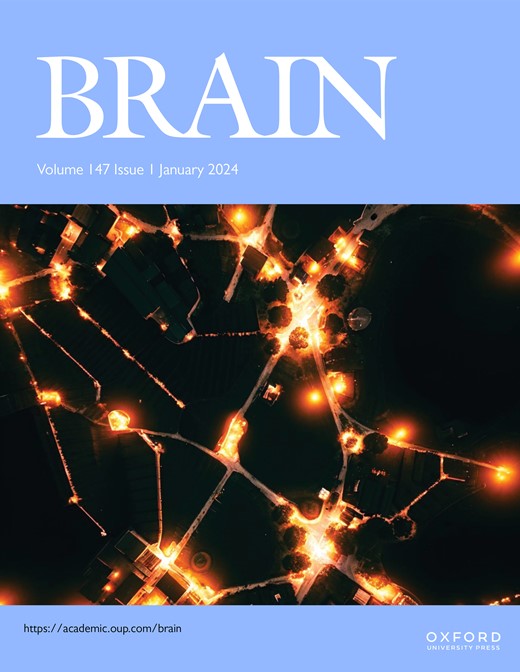人类中脑神经元亚群与精神分裂症相关的变化
IF 11.7
1区 医学
Q1 CLINICAL NEUROLOGY
引用次数: 0
摘要
人们认为精神分裂症患者的腹侧中脑存在功能失调的GABA能神经元和多巴胺能神经元,但这些异常的转录变化尚未定位到特定的神经元亚群。在腹侧中脑,多巴胺能活动的控制由兴奋性(谷氨酸)和抑制性(GABA)输入神经元共同维持。为了进一步阐明单细胞水平的神经元病理学,我们描述了人类腹侧中脑中不同 NEUN+ 群体的转录多样性,然后检测了精神分裂症相关的神经元亚群比例变化和神经元亚群内的基因活性变化。我们将单个核RNA测序与NEUN+核的荧光激活分选相结合,分析了31,669个核。最初,我们在人类腹侧中脑中检测到 18 个转录不同的神经元群体,其中包括 2 个 "混合 "群体。免疫组化染色正交验证了中脑中神经元群的存在。"混合 "群包含表达膀胱谷氨酸转运体 2(SLC17A6)和谷氨酸脱羧酶 2(GAD2)转录本的细胞核,但这些转录本通常不在同一细胞核中共同表达。对这两个 "混合 "群体进行更精细的分组后,又发现了 16 个转录为兴奋或抑制的亚群体。在精神分裂症患者的中脑中,我们观察到两个兴奋性神经元(亚)群、两个抑制性神经元亚群、一个 "混合 "亚群和一个表达 TH 的神经元亚群的比例存在潜在差异。这可能表明,与精神分裂症相关的转录变化会广泛影响兴奋性、抑制性和多巴胺神经元。在从两个 "混合 "群体中识别出的神经元亚群中,我们检测到精神分裂症患者与对照组相比有 99 个基因表达不同,其中大多数基因(67 个)的变化发生在 GABA 能神经元亚群中。总之,单核转录组分析揭示了人类腹侧中脑GABA能神经元的高度多样性,确定了神经元亚群比例的推测性变化,并提示了精神分裂症中特定GABA能亚群的功能障碍,为今后的研究提供了方向。本文章由计算机程序翻译,如有差异,请以英文原文为准。
Schizophrenia-associated changes in neuronal subpopulations in the human midbrain.
Dysfunctional GABAergic and dopaminergic neurons are thought to exist in the ventral midbrain of patients with schizophrenia, yet transcriptional changes underpinning these abnormalities have not yet been localized to specific neuronal subsets. In the ventral midbrain, control over dopaminergic activity is maintained by both excitatory (glutamate) and inhibitory (GABA) input neurons. To further elucidate neuron pathology at the single-cell level, we characterized the transcriptional diversity of distinct NEUN+ populations in the human ventral midbrain and then tested for schizophrenia-associated changes in neuronal subset proportions and gene activity changes within neuronal subsets. Combining single nucleus RNA-sequencing with fluorescence-activated sorting of NEUN+ nuclei, we analysed 31,669 nuclei. Initially, we detected 18 transcriptionally distinct neuronal populations in the human ventral midbrain, including 2 "mixed" populations. The presence of neuronal populations in the midbrain was orthogonally validated with immunohistochemical stainings. "Mixed" populations contained nuclei expressing transcripts for vesicular glutamate transporter 2 (SLC17A6) and Glutamate Decarboxylase 2 (GAD2), but these transcripts were not typically co-expressed by the same nucleus. Upon more fine-grained subclustering of the 2 "mixed" populations, 16 additional subpopulations were identified that were transcriptionally classified as excitatory or inhibitory. In the midbrains of individuals with schizophrenia, we observed potential differences in the proportions of two (sub)populations of excitatory neurons, two subpopulations of inhibitory neurons, one "mixed" subpopulation, and one subpopulation of TH-expressing neurons. This may suggest that transcriptional changes associated with schizophrenia broadly affect excitatory, inhibitory, and dopamine neurons. We detected 99 genes differentially expressed in schizophrenia compared to controls within neuronal subpopulations identified from the 2 "mixed" populations, with the majority (67) of changes within small GABAergic neuronal subpopulations. Overall, single-nucleus transcriptomic analyses profiled a high diversity of GABAergic neurons in the human ventral midbrain, identified putative shifts in the proportion of neuronal subpopulations, and suggested dysfunction of specific GABAergic subpopulations in schizophrenia, providing directions for future research.
求助全文
通过发布文献求助,成功后即可免费获取论文全文。
去求助
来源期刊

Brain
医学-临床神经学
CiteScore
20.30
自引率
4.10%
发文量
458
审稿时长
3-6 weeks
期刊介绍:
Brain, a journal focused on clinical neurology and translational neuroscience, has been publishing landmark papers since 1878. The journal aims to expand its scope by including studies that shed light on disease mechanisms and conducting innovative clinical trials for brain disorders. With a wide range of topics covered, the Editorial Board represents the international readership and diverse coverage of the journal. Accepted articles are promptly posted online, typically within a few weeks of acceptance. As of 2022, Brain holds an impressive impact factor of 14.5, according to the Journal Citation Reports.
 求助内容:
求助内容: 应助结果提醒方式:
应助结果提醒方式:


